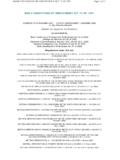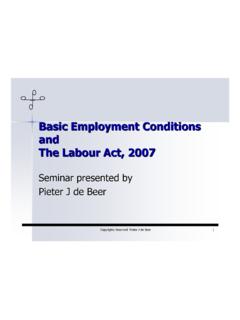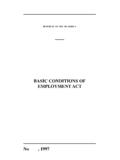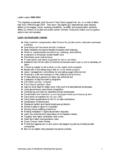Transcription of Gender - a Missing Dimension in Human Resource …
1 Special Article Gender a Missing Dimension in Human Resource policy And Planning for Health Reforms Hilary Standing, Fellow, Institute of Development Studies, University of Sussex, Brighton BN1 9RE, UK and Consultant, Health Sector Reform Programme, Liverpool School of Tropical Medicine Abstract This article takes up the relatively neglected issue of Gender in Human resources policy and planning (HRPP), with particular reference to the health sector in developing countries. Current approaches to Human resources lack any reference to Gender issues. Meeting the health needs of women as major users and potential beneficiaries of health services is a key international concern. This article argues that in order to do this, attention must also be paid to both equal opportunities and efficiency issues in the health sector workforce, given the highly Gender segregated nature of occupations in the health sector and the potential for both Gender inequity and inefficiency in the use of Human resources which this poses.
2 Taking Gender seriously in HRPP entails developing appropriate methodologies for data collection, monitoring and evaluation. The paper suggests some basic ways of doing this and provides a framework for incorporating Gender concerns in health reform processes. Key words: Gender , health providers, Human resources planning, health sector reform 1. Context - why consider Gender in Human Resource policy and planning? In view of the importance of Human resources planning to delivering the health sector reform agenda, the lack of attention to its Gender dimensions requires rectifying. This is a preliminary attempt to address the issue and provide some guidance in how to make Human resources policy and planning more Gender aware. It is based mainly on secondary sources and focuses particularly on nursing.
3 In general, most work on Gender and health care has focused on demand side issues. These include in particular the wide range of barriers to institutional access experienced by women users(1,2), Gender discrimination in health care expenditure affecting women and girls, the exclusive concentration on women s reproductive health to the neglect of other dimensions of their health(3), and the impact of cost recovery programmes on women and children(4). There has been much less emphasis on Gender in relation to the production of health care (5,6). Yet there is often a clear Gender Dimension to both formal and informal care systems. Much of the non-institutional care of the sick is carried out by female household and community members(7).
4 Similarly, formal health systems tend to be Gender differentiated in terms of their divisions of labour and associated hierarchies, with women frequently concentrated in specific segments of the health care labour force. They are less likely than men to be in senior professional, managerial and policy making roles(5,8,9). A study of Human resources in Zimbabwe notes that women s formal sector employment is mainly in the service sector. In health, women outnumber men as employees, holding of the total employment(10). It also notes that women are concentrated at the lower end of the hierarchy and salary grades. 12. Human resources and health sector reform During the 1970s and 80s, considerable investment was made by both donors and national governments in poor countries to increase the number of health workers to meet primary health care objectives(11).
5 Very substantial numbers were trained to varying levels of skill at considerable cost. Yet with the exception of a few areas, such as immunisation drives, major improvements in access to services have not taken place and better health outcomes, particularly for poorer, rural populations, have not always materialised. Access to and utilisation of services, particularly by poorer populations and by women, remains a major problem. Thus, the paradox is that health is a labour intensive sector - salaries generally make up the bulk of health sector expenditure - yet the investment in expanding the workforce has not yielded an equivalent return. Partly in recognition of this, health sector reform policies in a number of countries have begun to address the issue of Human resources, particularly through public sector reforms and strategies for improved Human Resource management.
6 Human resources restructuring is central to the implementation of health sector reform initiatives in developing countries. One of the major objectives of health sector reform must be to make better use of existing trained personnel and of those currently undergoing training. Key reforms, such as decentralisation, district management strengthening and civil service reform depend on appropriate and imaginative use of Human resources. Decisions on pay and reward structures, accountability and regulation will all influence the outcomes of these reforms and the quality of services they are intended to improve. However, Human resources planning and policy has failed in several respects to deliver an appropriately trained workforce to the places where it is actually needed (12).
7 Areas of failure include: poor selection of candidates for training ( through urban bias in recruitment); inappropriate training curricula ( lack of sensitivity to users and their needs); failure to recruit for and retain personnel in rural areas; failure to create contractual conditions which would ensure staff carry out the work for which they are paid; failure to manage or reverse the decline in health workers pay and conditions of service; inappropriate career structures ( ones which remove health workers from practice); failure to stem the exodus from the public to the private sector or to other countries. HRPP has generally been top down and concerned with bureaucratic targets.
8 This article puts forward two key arguments. First, the failures of HRPP can be related to the failure to take account of qualitative factors which in practice determine who enters the workforce, for how long, where they work and under what terms and conditions. Gender is one such major qualitative factor. The health sector workforce is one of the most female in composition,1 particularly at basic service level. For 1 It is recognised that this varies from country to country. Anglophone countries may be more female dominated than Francophone ones. The point still remains that the health sector is one of the few major formal sector employers of women in sub-Saharan Africa.
9 2example, in southern Africa, front line nursing care is provided overwhelmingly by nurses. Historically, in this region, nursing is a female profession (13). Second, HRPP has not involved the stakeholders themselves in any serious way in the design of training and career paths. Users views and concerns about health service delivery are only now being acknowledged as important. Provider stakeholders (whether individuals or associations) have also not been conspicuously consulted about Human Resource development strategies. HRPP must find ways of meeting the needs of users and also of satisfying the legitimate aspirations of providers. So far, very little systematic attention has been paid to the Gender Dimension of Human resources in the restructuring of the health sector (6).
10 2 This accords with a more general Gender blindness in the Human resources area. Whilst the disaggregation of the health workforce by sex is sometimes part of Human resources data collection (14), this information rarely seems to be used or factored into policy making. Indeed, it is not at all clear why it is collected in the first place. Yet, in the health sector, occupations such as nursing and midwifery are very Gender defined. There may also be imbalances in the representation of the genders at different levels of the structure, with women disproportionately represented at lower levels and in certain front line positions. Women may also be targeted specifically for paramedical roles in the health sector at local level, such as in family planning or maternal health programmes and as unpaid community health workers (15).

















